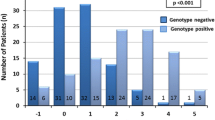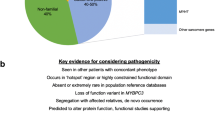Abstract
This study sought to determine the usefulness of genetic testing to predict evolution in hypertrophic cardiomyopathy (HCM) and to assess the role of genetic testing in clinical practice. Genetic results of 100 HCM patients tested for mutations in ≥10 HCM-causing genes were evaluated. Patients were classified as with poor (group A) or favourable (group B) clinical course. Forty-five pathogenic mutations (PM) were identified in 28 patients (56 %) from group A and in 23 (46 %) from group B (p = 0.317). Only 40 patients (40 %) exhibited PM that had been previously reported and only 15 (15 %) had PM reported in ≥10 individuals. PM associated with poor prognosis were identified in just five patients from group A (10 %). Genetic findings are not useful to predict prognosis in most HCM patients. By contrast, real-world data reinforce the usefulness of genetic testing to provide genetic counselling and to enable cascade genetic screening.

Similar content being viewed by others
Change history
15 July 2019
The name of author M. Alejandra Restrepo-Cordoba was parsed incorrectly (in such a way as to suggest that her surname is ���Alejandra Restrepo-Cordoba���) in this article as published.
15 July 2019
The name of author M. Alejandra Restrepo-Cordoba was parsed incorrectly (in such a way as to suggest that her surname is ���Alejandra Restrepo-Cordoba���) in this article as published.
Abbreviations
- HCM:
-
Hypertrophic cardiomyopathy
- HT:
-
Heart transplant
- ICD:
-
Implantable cardioverter defibrillator
- NGS:
-
Next-generation sequencing
- PM:
-
Pathogenic mutation
- SCD:
-
Sudden cardiac death
- VUS:
-
Variant of uncertain significance
References
Maron, B. J., Ommen, S. R., Semsarian, C., Spirito, P., Olivotto, I., & Maron, M. S. (2014). Hypertrophic cardiomyopathy: present and future, with translation into contemporary cardiovascular medicine. Journal of the American College of Cardiology, 64(1), 83–99.
Maron, B. J., Maron, M. S., & Semsarian, C. (2012). Genetics of hypertrophic cardiomyopathy after 20 years: clinical perspectives. Journal of the American College of Cardiology, 60(8), 705–715.
Garcia-Pavia, P., Vázquez, M. E., Segovia, J., Salas, C., Avellana, P., Gómez-Bueno, M., et al. (2011). Genetic basis of end-stage hypertrophic cardiomyopathy. European Journal of Heart Failure, 13(11), 1193–1201.
Li, Q., Gruner, C., Chan, R. H., Care, M., Siminovitch, K., Williams, L., et al. (2014). Genotype-positive status in patients with hypertrophic cardiomyopathy is associated with higher rates of heart failure events. Circulation. Cardiovascular Genetics, 7(4), 416–422.
Ho, C. Y., Charron, P., Richard, P., Girolami, F., Van Spaendonck-Zwarts, K. Y., & Pinto, Y. (2015). Genetic advances in sarcomeric cardiomyopathies: state of the art. Cardiovascular Research, 105(4), 397–408.
Landstrom, A. P., & Ackerman, M. J. (2010). Mutation type is not clinically useful in predicting prognosis in hypertrophic cardiomyopathy. Circulation, 122(23), 2441–2449.
Ho, C. Y. (2010). Genetics and clinical destiny: improving care in hypertrophic cardiomyopathy. Circulation, 122(23), 2430–2440.
Watkins, H., McKenna, W. J., Thierfelder, L., Suk, H. J., Anan, R., O’Donoghue, A., et al. (1995). Mutations in the genes for cardiac troponin T and alpha-tropomyosin in hypertrophic cardiomyopathy. The New England Journal of Medicine, 332(16), 1058–1064.
Ripoll-Vera, T., Gámez, J. M., Govea, N., Gómez, Y., Núñez, J., Socías, L., et al. (2016). Clinical and prognostic profiles of cardiomyopathies caused by mutations in the troponin T gene. Revista Española de Cardiología, 69(2), 149–158.
Calore, C., De Bortoli, M., Romualdi, C., Lorenzon, A., Angelini, A., Basso, C., et al. (2015). A founder MYBPC3 mutation results in HCM with a high risk of sudden death after the fourth decade of life. Journal of Medical Genetics, 52(5), 338–347.
García-Pavía, P., Segovia, J., Molano, J., Mora, R., Kontny, F., Erik Berge, K., et al. (2007). High-risk hypertrophic cardiomyopathy associated with a novel mutation in cardiac myosin-binding protein C. Revista Española de Cardiología, 60(3), 311–314.
Van Driest, S. L., Ackerman, M. J., Ommen, S. R., Shakur, R., Will, M. L., Nishimura, R. A., et al. (2002). Prevalence and severity of “benign” mutations in the beta-myosin heavy chain, cardiac troponin T, and alpha-tropomyosin genes in hypertrophic cardiomyopathy. Circulation, 106(24), 3085–3090.
Page, S. P., Kounas, S., Syrris, P., Christiansen, M., Frank-Hansen, R., Andersen, P. S., et al. (2012). Cardiac myosin binding protein-C mutations in families with hypertrophic cardiomyopathy: disease expression in relation to age, gender, and long term outcome. Circulation. Cardiovascular Genetics, 5(2), 156–166.
Elliott, P. M., Anastasakis, A., Borger, M. A., Borggrefe, M., Cecchi, F., Charron, P., et al. (2014). ESC guidelines on diagnosis and management of hypertrophic cardiomyopathy. European Heart Journal, 35(39), 2733–2737.
García-Giustiniani, D., Arad, M., Ortíz-Genga, M., Barriales-Villa, R., Fernández, X., Rodríguez-García, I., et al. (2015). Phenotype and prognostic correlations of the converter region mutations affecting the β myosin heavy chain. Heart, 101(13), 1047–1053.
Gersh, B. J., Maron, B. J., Bonow, R. O., Dearani, J. A., Fifer, M. A., Link, M. S., et al. (2011). ACCF/AHA guideline for the diagnosis and treatment of hypertrophic cardiomyopathy. Circulation, 124(24), e783–e831.
Cuenca S, Ruiz-Cano MJ, Gimeno-Blanes JR, Jurado A, Salas C, Gomez-Diaz I, et al. (2016) Inherited Cardiac Diseases Program of the Spanish Cardiovascular Research Network (Red Investigación Cardiovascular) Genetic basis of familial dilated cardiomyopathy patients undergoing heart transplantation. The Journal of Heart and Lung Transplantation 35(5):625–635
Charron, P., Dubourg, O., Desnos, M., Bennaceur, M., Carrier, L., Camproux, A. C., et al. (1998). Clinical features and prognostic implications of familial hypertrophic cardiomyopathy related to the cardiac myosin-binding protein C gene. Circulation, 97(22), 2230–2236.
Lopes, L. R., Rahman, M. S., & Elliott, P. M. (2013). A systematic review and meta-analysis of genotype-phenotype associations in patients with hypertrophic cardiomyopathy caused by sarcomeric protein mutations. Heart, 99(24), 1800–1811.
Biagini, E., Olivotto, I., Iascone, M., Parodi, M. I., Girolami, F., Frisso, G., et al. (2014). Significance of sarcomere gene mutations analysis in the end-stage phase of hypertrophic cardiomyopathy. The American Journal of Cardiology, 114(5), 769–776.
Girolami, F., Ho, C. Y., Semsarian, C., Baldi, M., Will, M. L., Baldini, K., et al. (2010). Clinical features and outcome of hypertrophic cardiomyopathy associated with triple sarcomere protein gene mutations. Journal of the American College of Cardiology, 55(14), 1444–1453.
Gajendrarao, P., Krishnamoorthy, N., Selvaraj, S., Girolami, F., Cecchi, F., Olivotto, I., et al. (2015). An investigation of the molecular mechanism of double cMyBP-C mutation in a patient with end-stage hypertrophic cardiomyopathy. Journal of Cardiovascular Translational Research, 8(4), 232–243.
Santos, S., Marques, V., Pires, M., Silveira, L., Oliveira, H., Lança, V., et al. (2012). High resolution melting: improvements in the genetic diagnosis of hypertrophic cardiomyopathy in a Portuguese cohort. BMC Medical Genetics, 19, 13–17.
Bottillo, I., D’Angelantonio, D., Caputo, V., Paiardini, A., Lipari, M., De Bernardo, C., et al. (2016). Molecular analysis of sarcomeric and non-sarcomeric genes in patients with hypertrophic cardiomyopathy. Gene, 577(2), 227–235.
Claes, G. R., van Tienen, F. H., Lindsey, P., Krapels, I. P., Helderman-van den Enden, A. T., Hoos, M. B., et al. (2016). Hypertrophic remodelling in cardiac regulatory myosin light chain (MYL2) founder mutation carriers. European Heart Journal, 37(23), 1815–1822.
Pasipoularides, A. (2015). Linking genes to cardiovascular diseases: gene action and gene-environment interactions. Journal of Cardiovascular Translational Research, 8(9), 506–527.
Ackerman, M. J., Van Driest, S. V., Ommen, S. R., Will, M. L., Nishimura, R. A., Tajik, A. J., et al. (2002). Prevalence and age-dependence of malignant mutations in the beta-myosin heavy chain and troponin T gene in hypertrophic cardiomyopathy: a comprehensive outpatient perspective. Journal of the American College of Cardiology, 39(12), 2042–2048.
Ingles, J., McGaughran, J., Scuffham, P. A., Atherton, J., & Semsarian, C. (2012). A cost-effectiveness model of genetic testing for the evaluation of families with hypertrophic cardiomyopathy. Heart, 98(8), 625–630.
Barriales-Villa, R., Gimeno-Blanes, J. R., Zorio-Grima, E., Ripoll-Vera, T., Evangelista-Masip, A., Moya-Mitjans, A., et al. (2016). Plan of action for inherited cardiovascular diseases: synthesis of recommendations and action algorithms. Revista Española de Cardiología, 69(3), 300–309.
Boletín Oficial de la Comunidad de Madrid de 10 de Septiembre de 2013 [Accessed 5 Dec 2015]. Available at: http://w3.bocm.es/boletin/CM_Orden_bocm/2013/09/10/BOCM-20130910-1.pdf.
Boletín Oficial de las Islas Baleares de 21 de Julio de 2014. [Accessed 5 Dec 2015]. Available at: http://www.caib.es/eboibfront/pdf/es/2014/89/875477
Murphy, S. L., Anderson, J. H., Kapplinger, J. D., Kruisselbrink, T. M., Gersh, B. J., Ommen, S. R., et al. (2016). Evaluation of the Mayo Clinic phenotype-based genotype predictor score in patients with clinically diagnosed hypertrophic cardiomyopathy. Journal of Cardiovascular Translational Research, 9(2), 153–161.
Author information
Authors and Affiliations
Corresponding author
Ethics declarations
Funding
This work was supported in part by an unrestricted grant from Ferrer in Code SL and by the Instituto de Salud Carlos III [grants RD012/0042/0059, RD012/0042/0066 and RD12/0042/0069] through the Plan Estatal de I+D+I 2013–2016—European Regional Development Fund (FEDER) “A way of making Europe”. The funders had no role in study design, data collection and analysis, decision to publish or preparation of the manuscript.
Disclosures
RB reports consulting fees from Ferrer in Code. The other authors have no conflicts of interest to declare.
Additional information
Associate Editor Paul J. R. Barton oversaw the review of this article.
Clinical relevance of the manuscript
Hypertrophic cardiomyopathy (HCM) is a heterogeneous disease with a broad clinical spectrum related to its diverse genetic profile. Although genetic findings are not currently recommended to predict prognosis, very few studies have analysed this issue and controversy remains about the usefulness of genetic testing to predict disease progression. The current study provides comprehensive data to support the view that genetic findings are not useful to predict prognosis in HCM patients. Our results indicate that it is not appropriate to perform genetic testing in HCM patients to predict patients’ and relatives’ clinical course. By contrast, real-world data obtained in this study reinforces the usefulness of genetic testing to provide genetic counselling and to enable familial evaluation.
Electronic Supplementary Material
ESM 1
(DOCX 103 kb)
Rights and permissions
About this article
Cite this article
Alejandra Restrepo-Cordoba, M., Campuzano, O., Ripoll-Vera, T. et al. Usefulness of Genetic Testing in Hypertrophic Cardiomyopathy: an Analysis Using Real-World Data. J. of Cardiovasc. Trans. Res. 10, 35–46 (2017). https://doi.org/10.1007/s12265-017-9730-8
Received:
Accepted:
Published:
Issue Date:
DOI: https://doi.org/10.1007/s12265-017-9730-8




